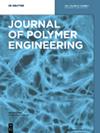GMA和TMPTA作为助剂对紫外光诱导反应挤出PLLA支化结构的协同调节作用
IF 1.7
4区 工程技术
Q4 POLYMER SCIENCE
引用次数: 0
摘要
摘要本文采用甲基丙烯酸缩水甘油酯(GMA)和丙三丙烯酸酯三羟甲基酯(TMPTA)对聚L-丙交酯酸(PLLA)在紫外光诱导反应挤出过程中的支化结构进行了调整。GMA环氧化物与PLLA链末端羧基或羟基的反应可以在PLLA分子链上引入C=C基团。通过TMPTA中乙烯基与PLLA骨架和C=C基封端的PLLA的自由基接枝反应,在紫外线照射下发生链支化反应。结果,通过改变GMA和TMPTA的比例,可以获得不同的分支水平。进行了与支链相关的流变特性和尺寸专属色谱的表征,以评估支链程度。在支链PLLA样品中观察到剪切粘度和端区储能模量的增加以及支链度的降低。1H-NMR和FIRT结果表明,GMA在PLLA上的接枝反应是成功的。因此,本研究提出了一种以GMA和TMPTA为助剂调整LCB-PLA结构的策略,这对PLA产品的工业化具有重要意义。本文章由计算机程序翻译,如有差异,请以英文原文为准。
Synergistic effect of GMA and TMPTA as co-agent to adjust the branching structure of PLLA during UV-induced reactive extrusion
Abstract In this work, glycidyl methacrylate (GMA) and trimethylol propanetriacrylate (TMPTA) are employed to adjust the branching structure of poly L-lactide acid (PLLA) during reactive extrusion induced by UV irradiation. The reaction of GMA epoxide with terminal carboxyl or hydroxyl groups at PLLA chain end can introduce C=C groups onto PLLA molecular chains. Chain branching reaction occurred via the free-radical grafting reaction of the vinyl group in TMPTA with both PLLA backbone and the C=C group terminated PLLA induced by UV irradiation. As a result, varied branching levels can be obtained by changing the ratio of GMA and TMPTA. The characterizations of rheological properties and size exclusive chromatograph correlated to the chain branches were performed to evaluate the chain branching extent. The increases in shear viscosity and storage modulus at terminal zone, and the reduced branching degree were observed in the branched PLLA samples. The results from 1H-NMR and FIRT indicate that the grafting reaction of GMA onto PLLA take place successfully. Thus, this study proposes a strategy to adjust LCB-PLA structure using GMA and TMPTA as co-agents, which is of great importance for the industrialization of PLA products.
求助全文
通过发布文献求助,成功后即可免费获取论文全文。
去求助
来源期刊

Journal of Polymer Engineering
工程技术-高分子科学
CiteScore
3.20
自引率
5.00%
发文量
95
审稿时长
2.5 months
期刊介绍:
Journal of Polymer Engineering publishes reviews, original basic and applied research contributions as well as recent technological developments in polymer engineering. Polymer engineering is a strongly interdisciplinary field and papers published by the journal may span areas such as polymer physics, polymer processing and engineering of polymer-based materials and their applications. The editors and the publisher are committed to high quality standards and rapid handling of the peer review and publication processes.
 求助内容:
求助内容: 应助结果提醒方式:
应助结果提醒方式:


